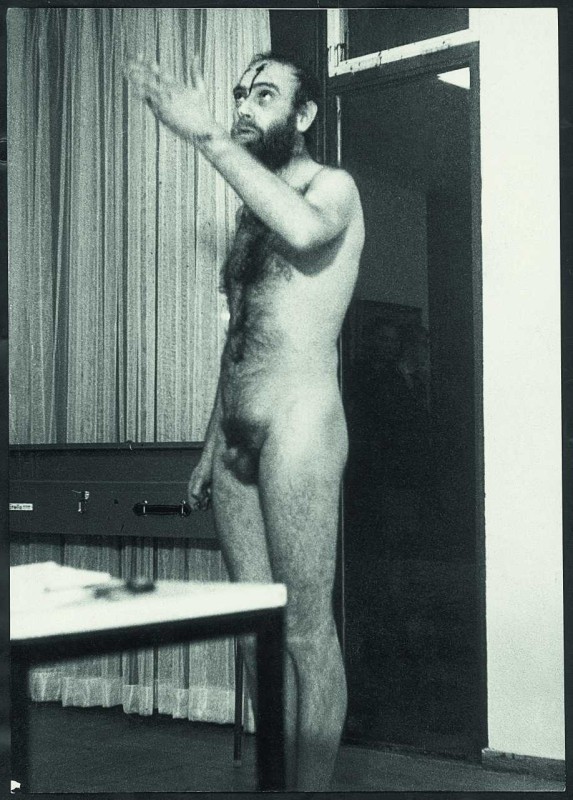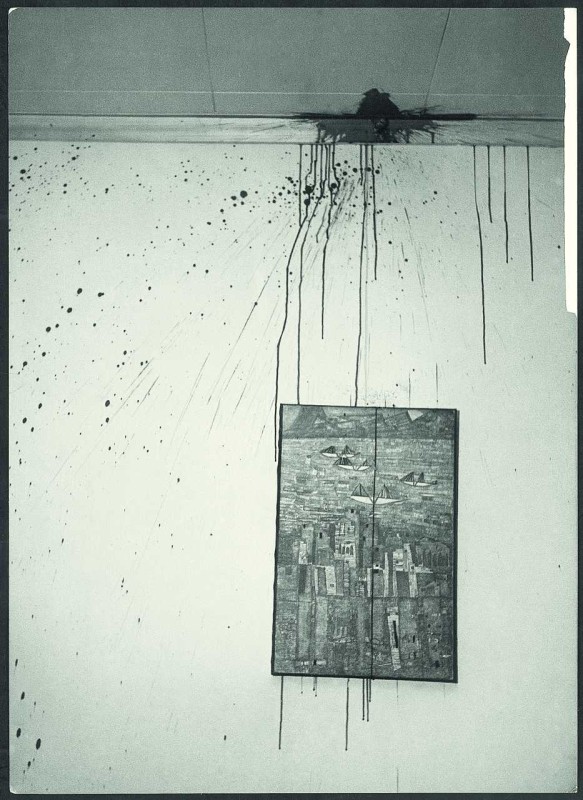ARCH 9
673
DEMONSTRATION AGAINST RATIONALISM IN ARCHITECTURE
Architecture demonstration 1968
Second nude demonstration on the occasion of the opening of an exhibition of Hundertwasser works, January 25, 1968.
mehr weniger- KunstHausWien, Vienna, 2011
- W. Schurian (ed.), Schöne Wege, Munich, 1983, p. 269 (b)
- Das Hundertwasser Haus, Vienna, 1985, pp. 59-60 (and b)
- H. Rand, Hundertwasser, Cologne, 1991, p. 139 (b) and ed. 1993, p. 119 (b)
- Hundertwasser Architektur, Cologne, 1996, pp. 56-58 (and b) and ed. 2006, pp. 42-44 (and b), 311
- P. Restany, Die Macht der Kunst, Hundertwasser - Der Maler-König mit den fünf Häuten, Cologne, 1998, p. 28 (b) and ed. 2018, p. 16 (b)
- R. Schediwy, Hundertwassers Häuser, Vienna, 1999, pp. 16 (b), 27 (b)
- A. C. Fürst, Hundertwasser 1928-2000, Catalogue Raisonné, Cologne, 2002, Vol. II, pp. 1177/1178 (and b)
- G. Illetschko, Planet Hundertwasser, Munich, 2012, p. 45 (b)
- C. Wiesauer, 100 x Hundertwasser, Vienna, 2016, p. 56 (b)
- World Travelling Museum Exhibition
- Musée d'Art Moderne de la Ville de Paris, 1975, p. 483 (b)
- Musée de l'Etat, Luxembourg, 1975, p. 537 (b)
- Musée Cantini, Marsaille, 1975, P. 537 (b)
- A.S.U. Hall, Cairo, 1975, p. 537 b)
- The Tel Aviv Museum, 1976, p. 477 (b)
- National Gallery of Iceland, Reykjavik, 1976, p. 401 (b)
- Statens Museum for Kunst, Copenhagen, 1976, p. 483 (b)
- Musée Dynamique, Dakar, 1976, p. 483 (b)
- South African National Gallery, Cape Town/Pretoria Art Museum, 1977, p. 477 (b)
- Museu de Arte Moderna, Rio de Janeiro/Museu deArte, Sao Paulo/Palácio Itamaraty, Brasilia, 1977, p. 477 (b)
- Museo de Bellas Artes, Caracas, 1977, p. 477 (b)
- Museo de Arte Moderno, Mexico City, 1978, p. 477 (b)
- Musée des Beaux-Arts, Montreal, 1978, p. 483 (b)
- Royal Ontario Museum, Toronto, 1978, p. 477 (b)
- Palais des Beaux-Arts, Brussels, 1978, p. 483 (b)
- Palazzo Barberini, Rome, 1980, p. 477 (b)
- Sonja Henies og Niels Onstads Stiftelser Kunstsentret, Hovikodden, 1980, p. 477 (b)
- Museum Ludwig, Cologne, 1980, p. 461 (b)
- Secession, Vienna, 1981, p. 461 (b)
- Kulturhaus, Graz, 1981, p.461 (b)
- Helsingin kaupungin taidemuseo, Helsinki, 1981, p. 477 (b)
- Barbican Art Gallery, London, 1983, p. 477 (b) **
- Wonen in Wenen - Sociale Woningbouw met visie (Europalia 87 Österreich), Hessenhuis, Antwerp, 1987, p. 132 (b)
- Travelling exhibition DAM, 2005/06, p. 106 (b)
- A Magical Eccentric, Szépmüvészeti Múzeum, Budapest, 2007, p. 161 (b)
- Der unbekannte Hundertwasser, KunstHausWien, Vienna, 2008, p. 32 (b)
- HW-Die Kunst des grünen Weges, KunstHausWien, Vienna, 2011, p. 121
- Gegen den Strich. Werke 1949-1970, Kunsthalle Bremen, 2012/13, pp. 232-235 (and b)
- Hundertwasser, Japan und die Avantgarde, Österreichische Galerie Belvedere, Orangerie, Vienna, 2013, p. 69 (b)
- G. Habarta, Frühere Verhältnisse, Vienna, 1996, pp. 384/385 (and b)
- L. Weintraub, To Life! Eco Art in Pursuit of a Sustainable Planet, Berkeley, 2012, p. 82 (b)


Hundertwasser's comment on the work
I had assumed that the building would be a modern functional construction and for this reason had taken along two hollow eggs filled with india ink, one with red, the other with black ink. (...) On arrival I saw my direst fears confirmed as to the architecture and decided to make a strong protest. The protest with the ink-filled eggs was arrived at after making the following consideration: to change a building's architecture requires much time and a great deal of building materials. I did not have time like this at my disposal. I wanted to make a drastic and symbolic change in the architecture by applying black and red ink to the lifeless walls. (...) Under this impression of shock from the ink-throwing I quickly undressed. (...) It is my conviction that man is surrounded by three layers: by his skin, his clothing and a building. Clothing and buildings have undergone a development in the last centuries which is no longer in tune with nature and the requirements of the individual. As a consequence of the mass aspects of society, inapproriate things are forced on the individual. To protest against these circumstances in the realm of architecture was the purpose of the ink demonstration; my undressing served to protest against the oppression through clothing. Now the naked individual in the natural state was to be established as the herald of protest and placed alongside corrected architecture.
(excerpt from a protocol, January 26, 1968, in: Hundertwasser Architecture, Cologne, 1997, pp. 56-58)